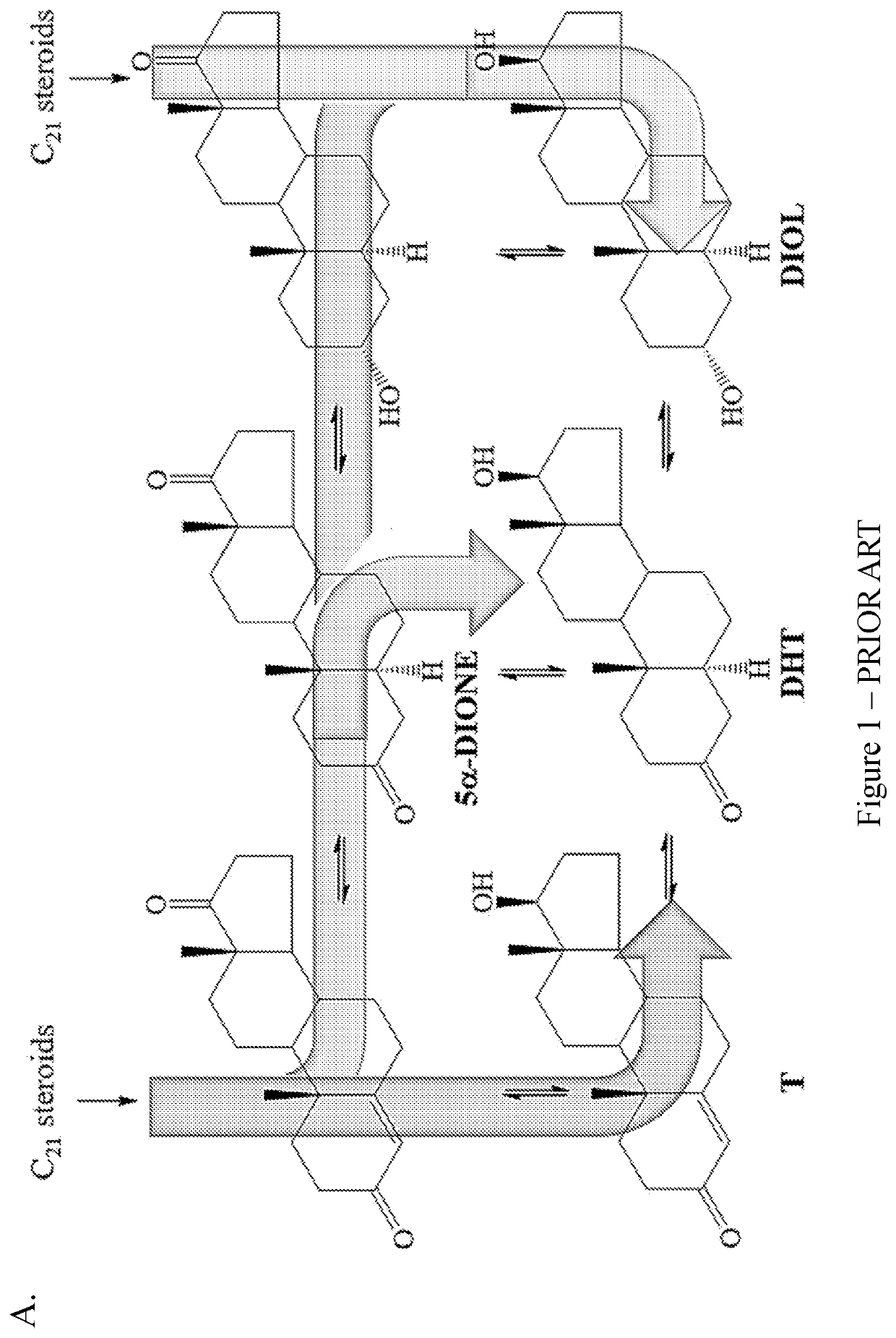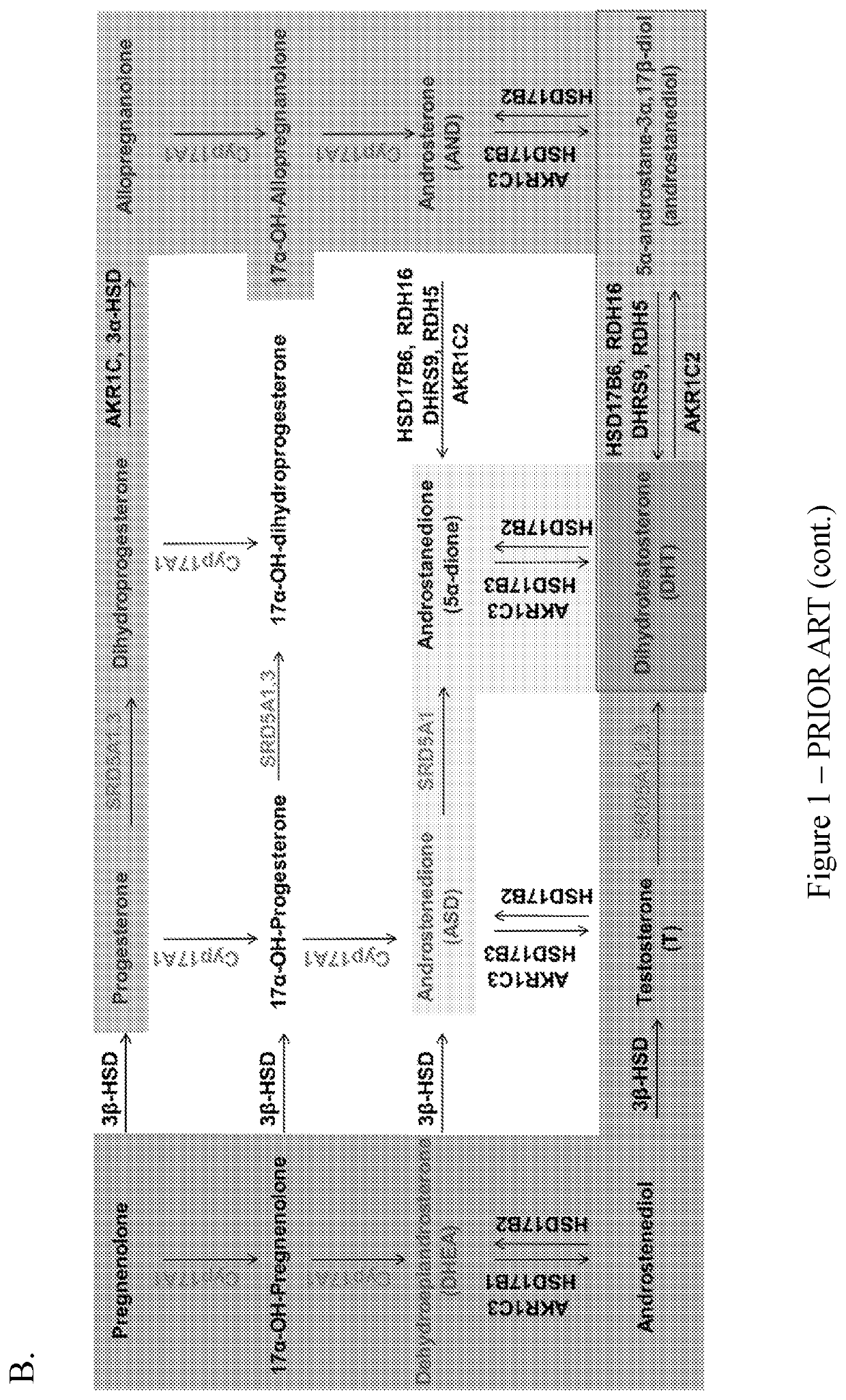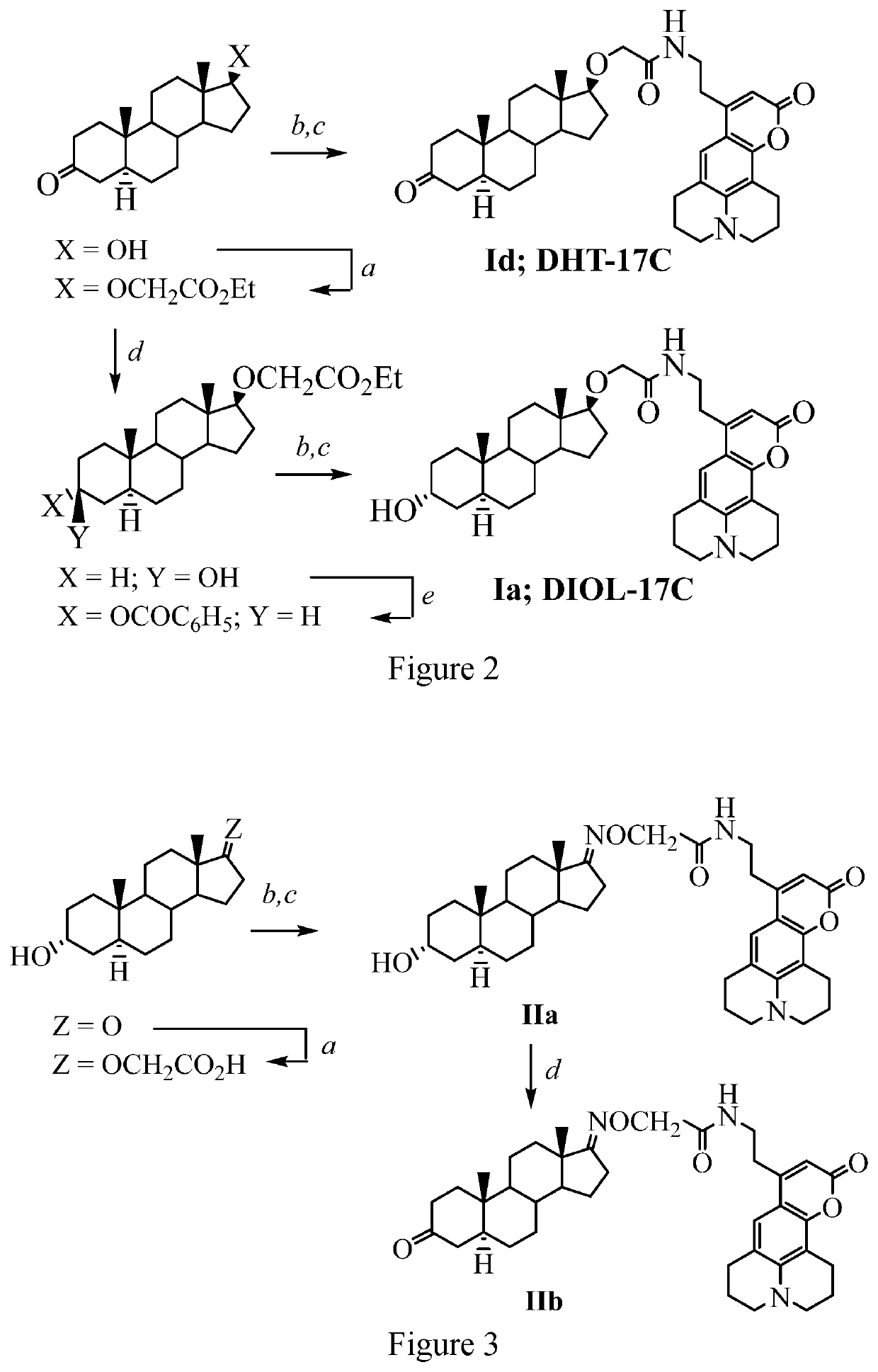Coumarin-modified androgens for the treatment of prostate cancer
a technology of androgens and coumarin, which is applied in the direction of nitrile/isonitrile active ingredients, organic chemistry, drug compositions, etc., can solve the problems of invariably recurring, clinical failure of both agents, and failure of therapeutics, and achieve the effect of dimerization of ar-ar-v7
- Summary
- Abstract
- Description
- Claims
- Application Information
AI Technical Summary
Benefits of technology
Problems solved by technology
Method used
Image
Examples
example 1
[0106]This example provides a description of compounds of the present disclosure.
[0107]Synthesis of compound (Ia aka DIOL-17C) where R1 and R2 are hydrogen as shown below and in FIG. 2:
[0108]Ethyl (3-Keto-5α-androstan-17β-yl)glycolate. To a suspension of 1 g (3.44 mmol) of androstane-17β-ol-3-one and 95 mg (0.22 mmol, 0.064 eq.) of dirhodium tetraacetate in 10 mL of CH2Cl2 at 0° C. was added dropwise 393 mg (3.44 mmol, 1 eq.) of ethyl diazoacetate with vigorous stirring. After 2 h at 25° C., an additional 393 mg (3.44 mmol, 1 eq) of ethyl diazoacetate was added dropwise, and the mixture was stirred for an additional 2 hours (h). The mixture was diluted with CH2Cl2, washed with water and brine, dried over anhydrous MgSO4, and concentrated. The product was purified by column chromatography using 1:3 EtOAc-hexane to afford 687 mg (53%) of ethyl (3-keto-5α-androstan-17β-yl)glycolate as a semisolid. 1H NMR (CDCl3, 500 MHz): δ 4.20 (q, 2H, J=7.2 Hz), 4.09 (s, 2H), 3.40 (t, 1H, J=8.5 Hz), ...
example 2
[0112]This example provides a description of compounds of the present disclosure. Synthesis of compound (Id aka DHT-17C) where R1 and R2 are hydrogen as shown in FIG. 2:
[0113]N-2′-(2,3,4,5-Tetrahydro-1H,4H-10-keto-11-oxa-3α-azabenzo[de]anthracenyl)ethyl (3-keto-5α-androstan-17β-yl)glycolamide. To a solution of 100 mg (0.27 mmol) of ethyl (3-keto-5α-androstan-17β-yl)glycolate in 4 mL of THF was added 0.28 mL (0.54 mmol, 2 eq.) of 2 N aqueous NaOH solution. The mixture was stirred for 5 h at 25° C. and concentrated. The residue was diluted with water and acidified with 3 N HCl solution to pH 2 to produce a white precipitate that was collected to afford 83 mg (90%) of (3-keto-5α-androstan-17β-yl)glycolic acid that was used in the next step without further purification. To a mixture of 37 mg (0.11 mmol) of this acid and 42 mg (0.12 mmol, 1.1 eq.) of 8-(2-aminoethyl)-2,3,4,5-tetrahydro-1H,4H-11-oxa-3α-aza-benzo[de]anthracen-10-one hydrochloride in 1 mL of CH2Cl2 were added successively 3...
example 3
[0114]This example provides a description of compounds of the present disclosure.
[0115]Synthesis of compound (IIa) where R1 is hydrogen as shown in FIG. 3:
[0116]17-(O-Carboxymethyloximino)-5α-androstan-3α-ol. A mixture of 537 mg (1.85 mmol) of 5α-androstan-3α-ol-17-one and 404 mg (3.7 mmol) of carboxymethoxylamine hemichloride in 20 mL of pyridine was stirred at 80° C. for 15 h. The product was cooled and concentrated. The product was diluted with water and extracted with CH2Cl2. The organic layer was washed with brine and dried over anhydrous MgSO4. The solvent was evaporated, and residue was recrystallized from acetone to afford 652 mg (97%) of a white solid: mp 171-173° C. mp 173-175° C. 1H NMR (CDCl3, 400 MHz): δ 4.57 (s, 2H), 4.05 (br s, 1H), 2.54-2.48 (m, 2H), 1.94-0.82 (m, 20H), 0.91 (s, 3H), 0.79 (s, 3H). 13C NMR (CDCl3, 100 MHz): δ 1743, 172.9, 69.8, 66.4, 54.3, 53.8, 44.5, 39.0, 36.1, 35.7, 34.8, 33.9, 320, 31.4, 30.9, 28.9, 28.2, 26.1, 23.0, 20.2, 17.1, 11.1.
[0117]8-Hydro...
PUM
| Property | Measurement | Unit |
|---|---|---|
| flow rate | aaaaa | aaaaa |
| pH | aaaaa | aaaaa |
| temperature | aaaaa | aaaaa |
Abstract
Description
Claims
Application Information
 Login to View More
Login to View More - R&D
- Intellectual Property
- Life Sciences
- Materials
- Tech Scout
- Unparalleled Data Quality
- Higher Quality Content
- 60% Fewer Hallucinations
Browse by: Latest US Patents, China's latest patents, Technical Efficacy Thesaurus, Application Domain, Technology Topic, Popular Technical Reports.
© 2025 PatSnap. All rights reserved.Legal|Privacy policy|Modern Slavery Act Transparency Statement|Sitemap|About US| Contact US: help@patsnap.com



